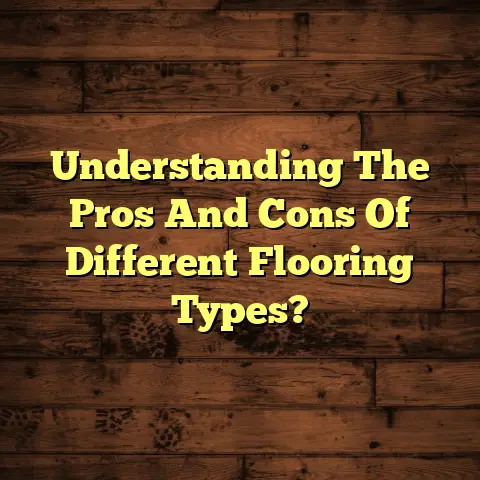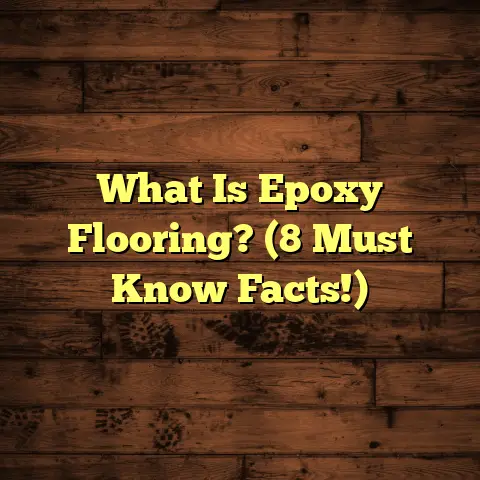Subfloor As Finished Floor? (1 BIG Mistake!)
Why did the floor refuse to go to school?
Because it was tired of being walked all over!
Trust me, it’s a bigger blunder than installing carpet in a bathroom!
Let’s dive into why this seemingly clever
shortcut can lead to a world of headaches
and empty wallets.
I’m talking about the
difference between a solid foundation and a
flooring faux pas.
Section 1: Understanding Flooring Basics
Okay, let’s break down the basics.
Think of your flooring system like a cake.
You need all the layers working together
to create something delicious and sturdy.
Definition of Subfloor
So, what exactly is a subfloor?
It’s the unsung hero of your flooring system.
It’s the structural layer directly on top of
your floor joists, providing a stable and
level base for your finished flooring.
Think of it as the cake’s foundation.
Common materials include plywood, OSB
(Oriented Strand Board), and sometimes even
concrete.
Plywood is known for its strength
and stability, while OSB is a more
cost-effective option.
However, OSB can be more susceptible to
moisture damage.
I’ve seen countless jobs where OSB subfloors
have buckled and warped due to even minor
leaks.
Not a pretty sight!
Definition of Finished Floor
Now, let’s talk about the star of the show:
the finished floor.
This is the material you see and walk on every day.
It’s the aesthetic layer, designed to be
durable, comfortable, and visually appealing.
We’re talking hardwood, laminate, tile,
carpet, vinyl – the whole shebang!
Each material has its own unique
characteristics and benefits.
Hardwood adds warmth and elegance, while
tile is incredibly durable and water-resistant.
Laminate offers a budget-friendly alternative
to hardwood, and carpet provides comfort and
sound insulation.
Importance of Each Layer in Flooring Systems
Why can’t we just skip the subfloor and slap
down some hardwood?
Well, because the subfloor is crucial for
several reasons:
-
Structural Support: It provides a solid base for the finished floor, preventing it from sagging, flexing, or cracking.
-
Moisture Control: It acts as a barrier against moisture from the crawl space or basement, protecting the finished floor from water damage.
-
Level Surface: It creates a smooth and even surface for the finished floor, ensuring a professional and aesthetically pleasing result.
Without a proper subfloor, your finished
floor is going to be in for a rough ride.
I’ve seen floors that felt like walking on
a trampoline because the subfloor was
inadequate.
Section 2: The Consequences of Using Subfloor as Finished Floor
Alright, let’s get to the heart of the matter.
Why is using a subfloor as a finished floor
such a bad idea?
Well, let me tell you, the consequences can
range from mildly annoying to downright disastrous.
Aesthetic Concerns
Let’s be honest, subfloors are not exactly
eye candy.
They are designed for function,
not beauty.
The texture is rough, the color is bland,
and the overall look is industrial and unfinished.
While some might see a certain “rustic” charm in exposed plywood or OSB, it’s generally not the kind of aesthetic you want in your living room or bedroom.
-
Texture: Subfloors are typically rough and splintery, making them uncomfortable to walk on and difficult to clean.
-
Color: The color is usually a dull, uninspiring shade of brown or gray.
Design Limitations: There are very few design options available with subfloors.
You’re pretty much stuck with the way it looks.
I had one client who tried to stain their OSB
subfloor to make it look more appealing.
It ended up looking like a muddy mess!
Trust me, there are better ways to add
character to your floors.
Durability Issues
Subfloors are simply not designed to
withstand the daily wear and tear that a
finished floor endures.
They are softer and more susceptible to
damage from scratches, dents, and warping.
-
Scratching: Even minor scratches can be highly visible on a subfloor, especially if it’s been stained or painted.
-
Denting: Heavy furniture or dropped objects can easily dent the surface of a subfloor.
-
Warping: Subfloors are prone to warping and swelling when exposed to moisture.
I once saw a subfloor that had been used as a
finished floor in a busy entryway.
It was covered in scratches, dents, and water
stains.
It looked like it had been through a war!
Comfort Factors
Let’s talk about comfort.
Walking on a subfloor is not exactly a
pleasant experience.
It’s hard, cold, and often uneven.
Thermal Properties: Subfloors have poor thermal properties, meaning they don’t retain heat well.
This can make your home feel colder in the winter.Noise Reduction: Subfloors offer very little noise reduction.
Every footstep will echo throughout the house.
I’ve had clients complain about how cold their
feet were in the winter when they had exposed
subfloors.
They also mentioned how noisy the house was,
especially with kids running around.
Section 3: Common Situations Where This Mistake Occurs
So, why do people make this mistake?
Well, there are a few common scenarios where
the allure of using a subfloor as a finished
floor becomes tempting.
DIY Projects
DIY projects are fantastic, but sometimes
enthusiasm can outweigh knowledge.
Many DIYers, eager to save time and money,
may not fully understand the difference
between a subfloor and a finished floor.
They might think, “Hey, it looks flat and
stable enough.
Why bother with another layer?”
Unfortunately, this can lead to problems down
the road.
I always advise DIYers to do their research
before starting any flooring project.
There are tons of resources available online,
including videos, articles, and forums.
Don’t be afraid to ask questions!
Renovations and Budget Constraints
Let’s face it, renovations can be expensive.
When budgets are tight, it’s tempting to cut
corners wherever possible.
Some homeowners might think that using a
subfloor as a finished floor is a clever way
to save money.
However, this is often a false economy.
In the long run, you’ll likely end up spending
more money to fix the problems caused by
using a subfloor as a finished floor.
I always tell my clients that it’s better to
do it right the first time, even if it means
spending a little more upfront.
Quality flooring is an investment that will
pay off in the long run.
According to a 2023 report by the National
Association of Home Builders (NAHB), flooring
typically accounts for around 7% of the total
cost of a new home construction.
While it’s not the biggest expense, it’s
still a significant one.
Real Estate Flips
Real estate flippers are often under pressure
to complete renovations quickly and cheaply.
This can lead to poor decisions, such as using
a subfloor as a finished floor.
While flippers might be able to get away with
it in the short term, it’s likely to turn off
potential buyers.
Most people want a home that is move-in
ready, not one that requires immediate repairs.
I’ve seen countless flipped houses with
exposed subfloors.
They always look cheap and unfinished.
It’s a surefire way to turn off potential
buyers.
Section 4: Real-Life Examples and Case Studies
Let’s get into some real-life examples to illustrate the pitfalls of using a subfloor as a finished floor.
Homeowner Testimonials
I recently spoke with a homeowner named Sarah who made the mistake of using her OSB subfloor as a finished floor in her basement.
“I thought it would be a cool, industrial look,”
she said.
“But it turned out to be a disaster.
The floor was always cold and hard, and it
scratched so easily.
Plus, it was impossible to keep clean.
I ended up having to replace the entire floor
after just a year.”
Another homeowner, Mark, tried to save money by using his plywood subfloor as a finished floor in his living room.
“It looked okay at first,” he said.
“But after
a few months, the floor started to warp and
crack.
It was a complete eyesore.
I ended up spending twice as much money to
fix the problem.”
Professional Insights
I asked a fellow flooring contractor, Tom, for his thoughts on using a subfloor as a finished floor.
“It’s a rookie mistake,” he said.
“I’ve seen
it happen so many times.
People think they’re being clever, but they
end up regretting it.
A subfloor is not
designed to be a finished floor.
It’s as simple as that.”
Another contractor, Lisa, added, “It’s not just
about aesthetics.
It’s about safety.
Subfloors can be slippery and uneven, which
can lead to falls.
It’s just not worth the risk.”
Before and After Comparisons
I once worked on a project where the homeowner had initially used their subfloor as a finished floor in their kitchen.
The “before” picture was not pretty.
The floor was stained, scratched, and uneven.
It looked like it belonged in a garage, not a
kitchen.
We replaced the subfloor with a beautiful
tile floor.
The “after” picture was a night
and day difference.
The kitchen was transformed into a bright,
modern, and inviting space.
The homeowner was thrilled with the results.
“I can’t believe I waited so long to fix it,”
she said.
“It’s like I have a brand new
kitchen!”
Section 5: Alternatives to Subfloor as a Finished Floor
Okay, so you’re convinced that using a
subfloor as a finished floor is a bad idea.
But what are your options?
Fortunately, there are plenty of cost-effective
alternatives that can give you the look you
want without compromising quality.
Cost-Effective Solutions
-
Laminate Flooring: Laminate is a budget-friendly alternative to hardwood that is durable, easy to install, and comes in a variety of styles and colors.
-
Vinyl Flooring: Vinyl is another affordable option that is water-resistant, easy to clean, and available in a wide range of patterns and textures.
-
Engineered Wood Flooring: Engineered wood is a more affordable alternative to solid hardwood that offers similar aesthetics and durability.
I often recommend laminate or vinyl flooring to
clients who are on a tight budget.
They offer a great combination of affordability,
durability, and style.
Flooring Styles and Trends
-
Wood-Look Tile: Wood-look tile is a popular trend that combines the beauty of hardwood with the durability of tile.
-
Large-Format Tiles: Large-format tiles are another popular trend that can create a sleek and modern look.
-
Waterproof Flooring: Waterproof flooring is becoming increasingly popular, especially in kitchens and bathrooms.
I always encourage my clients to explore different flooring styles and trends to find something that fits their personal taste and budget.
DIY-Friendly Options
-
Peel-and-Stick Vinyl Tiles: Peel-and-stick vinyl tiles are incredibly easy to install, making them a great option for DIYers.
-
Click-Lock Laminate Flooring: Click-lock laminate flooring is another DIY-friendly option that requires no glue or nails.
-
Floating Vinyl Plank: Floating vinyl plank is a durable and water-resistant option that is easy to install over existing floors.
I always emphasize the importance of investing
in the right materials and tools for any DIY
flooring project.
It’s better to spend a little more upfront to
ensure a professional and long-lasting result.
Conclusion
Let’s recap.
Using a subfloor as a finished
floor is generally a bad idea due to aesthetic
concerns, durability issues, and comfort factors.
While it might seem like a cost-saving measure,
it often leads to more problems and expenses
down the road.
There are plenty of cost-effective and DIY-friendly alternatives available that can give you the look you want without compromising quality.
So, the next time you’re considering a flooring
project, remember:
Don’t cut corners by using a subfloor as a
finished floor.
It’s a mistake that you’ll likely regret.
Why did the carpenter break up with the
flooring?
Because they couldn’t see eye to eye!





